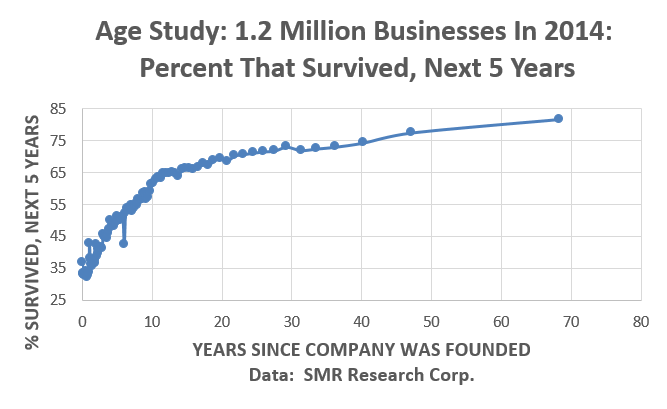Companies, Tenants & Risks
SMR’s Companies and Risks File

SMR maintains a proprietary database of over 37 million U.S. companies, schools and government facilities, built from over 470 official records sources.
We’ve matched these companies to our property files and inserted a unique key so that users can see which firms are tenants at which buildings. We also show whether the company is not merely a tenant, but owns the building it is in.
For each company, we have a basic information set, and also a unique set of risk information.
Basic information includes company name and address, trade (alias) name, type of business, startup date, date when the company moved to its current location, and owner or senior officer name and title. We have number of employees and phone numbers when disclosed in official government records.
Filling in Gaps
The Companies and Risks file fills in gaps in the tax assessor records, allowing us to more precisely describe what’s going on at millions of commercial buildings. It also identifies over 9 million home-based businesses.
Tax assessor files tell you who owns a building, but not the actual occupants of the building. Filling in that information is one of our key objectives.
Also, local tax assessors often describe a property as merely “commercial.” That doesn’t tell you much. But our Tenants Database might show a 7-Eleven store at that location, so we can then change the use to “convenience store.”
Not Just Another List of Companies
You may be thinking: This is nothing new. Other vendors also have mega-sized lists of U.S. companies, large and small. However, SMR’s Companies file provides additional value that no other single list can duplicate.
For example, a “standard” companies database will have one record for McDonald’s Corp., showing its headquarters in Illinois. Our Companies file includes not only the corporate headquarters, but also thousands of additional records for individual McDonald’s units across the country – often gleaned from public food inspection records.
Similarly, a typical company file is limited to commercial enterprises. But if your purpose is to understand who is in any commercial building, you must add in schools, post offices, police departments, and other non-business entities. All of these are included in SMR’s Companies and Risks File.
Call for more information: 908-852-7677.
Ownership and Building Data
Our Companies and Risks File brings together information from many public records, allowing you to see a more complete picture of any firm. More than 75% of the time, we know how long they have been in business – a key indicator of stability. We often have senior officer names, type of business descriptions, non-profit indicators, and postal-verified zip+4 addresses.
We also provide information which most competing business catalogs lack: we link our records to our own commercial and residential property databases, bringing in dozens of location-based details. The Companies
and Risks File allows you to see data on building size, value, and age; property owners, and much more.
Revealing Hidden Risks
Risk data make SMR’s companies file different from any other compilation of U.S. firms.
Commercial insurance firms and lenders need to know about any serious risks associated with a potential business customer. But some risks are hard to detect.
We have data on 20 risk categories applied to all companies. Most of these cannot be found on either company web sites or social media.
REGULATORY PROBLEMS
OSHA Safety Violations: Many companies have an occasional on-site injury or safety problem. But over 21,000 firms have had five or more violations in the last five years, or have been designated as “repeat” or “willful” violators by the Occupational Safety And Health Administration.
Wage and Hour Violators: U.S. labor law regulates pay for overtime, hiring of minor children, and other rules and regulations. More than 22,000 firms have had 10 or more violations in the last five years or have been classified as “repeat” or “willful” violators by the Department of Labor.
EPA Formal Enforcement Actions: The U.S. Environmental Protection Agency makes inspections, and problems they find are typically cleaned up. But when necessary, EPA takes formal enforcement actions. Some companies have been targeted with more than 100 of these! We have data on over 23,000 firms that have had at least one formal action taken against them during the last five years, the total number of actions, and the date of the last one.
STRUCTURE PROBLEMS
Old Buildings: Older buildings are generally more subject to water leaks, mold, and other problems. Nearly 2 million businesses are located in buildings first constructed prior to 1940. Our data come directly from virtually all the local tax assessors in the nation. Our Companies
and Risks File includes the year built for nearly seven million commercial buildings.
Underground Fuel Storage Tanks: Gas stations are obvious, but other firms also have these tanks. Will they leak? Over 200,000 companies had underground tanks in our last check.
Poor Building Quality/Condition: Tax assessors use appraisers to set a dollar value for a building. When we convert this into value per square foot, we can see that some values are much lower or higher than others in the same locales – even for buildings in the same use categories. These differences correlate with building age and other facts.
SMR has converted these differences into numeric scores, where a score of 100 is average. Buildings with scores of 40 or less, indicating a much lower value than other buildings of the same use type in their area, indicate a high likelihood of potential problems relating to the quality of the building.
CRIME LOCATION PROBLEMS TYPE OF BUSINESS RISKS FINANCIAL/SURVIVAL PROBLEMS Call for more information:
(908) 852-6809.
Crime Rates: There are 2 problems with using the latest FBI crime data on cities and towns:
1) Crime rates in the same city (and especially in small cities) can fluctuate
dramatically from year to year, and
2) Crime rates per 100,000 residents leave you wondering what “normal” is. You
get a number like 9.4, not knowing whether that’s good or bad.
Our solution is to average 3 recent years of the crime data, and then to express
the averages as a variance against the national norm. So, a variance of 1.20
would mean 20% higher crime over 3 years than the national average. And, we
have violent and property crime rates broken out.
FEMA Flood Zones: Our flood zone data at the individual address level are being updated regularly by the nation’s second-largest title insurance company, working with FEMA maps.
More than 900,000 companies are located in FEMA designated flood areas. We provide the official FEMA flood zone code.
Contaminated Sites: About 25,000 companies are located at contaminated or potentially contaminated sites, based on EPA inspections in the last 5 years. Risks can be grave. Our indicators specify “brownfield,” “contaminated,” or “potentially contaminated.”
Secondary Fire Risk: Nearly 1.4 million U.S. companies are not restaurants – yet they have secondary fire risk because they are at an address where a restaurant, food service, or bakery also resides. Our Companies
and Risks File identifies firms with such a secondary risk.
Hazardous Waste Transporters: Nearly 40,000 companies are licensed by the U.S. Department of Transportation to haul hazardous waste or substances. Some also are identified by the EPA.
Liquor Licenses: Companies with liquor licenses may have higher rates of crime and contents damage, plus risks associated with selling to minors. Recently, there were over 500,000 firms involved. Most are bars, restaurants, and liquor stores, but we also include the local clubs like VFW posts that may serve beer, wine, or liquor periodically. Most of our data come from state-level active liquor license records.
Child Care/Day Care Businesses: If a child is injured or becomes ill while in the care of one of these businesses, substantial liability risk exists. We count nearly 100,000 of these in the U.S., some of them home-based businesses. We include pre-schools and nurseries.
Commercial Vehicles and Crash Statistics: There are more than 900,000 firms in the U.S. operating one or more DOT-registered trucks. Of these, 109,594 companies recently had experienced accidents over the last three years. The total number of these crashes was 268,926.
Our Companies and Risks File includes the facts on all 900,000-plus firms, including the number of trucks each company operates. You can divide the number of accidents by the number of trucks to compute a crash rate by company. Our data also includes information on any crashes that resulted in fatalities with company-owned vehicles.
Mortgage Default: SMR receives a monthly updated stream of notices of mortgage default for commercial and residential property owners. A property in default may not be well-maintained, and a company that also owns the property may be in some financial jeopardy.
About 60,000 companies are at properties that have received notices of mortgage default over the last two years – and we identify whether the company owns the property or is merely a tenant.
IRS Tax Liens: The IRS discloses which commercial businesses have tax liens, and the amounts of those liens. They range from tiny amounts to millions of dollars. It’s important to check to see if those liens have been paid subsequent to our observation date. At last check, there were over 140,000 companies with open IRS tax liens.
Home Businesses: SMR’s forensic work shows that home-based businesses have lower survival rates than those located in commercial buildings. Our Companies File indicates when a business is home-based (or a residential home is at the same address). More than 1.3 million are identified.
Startups and Financial Risk: Startup firms have much lower-than-normal survival rates over any upcoming five-year span. Less well-known, survival rates change with each year that a company has been in business, as shown below.
Our Companies and Risks File includes a flag to identify whether it has been in business for less than three years. There recently were 1.06 million of them.
Economic Injury Disaster Loans (EIDLs): Under Covid-19 relief, the
government established these loans, and Unlike other
programs, these loans must be repaid, so you would only get one if you really
needed it. More than 5 million businesses have received them so far.


